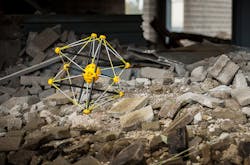Sensor Robots Can Handle Hazardous Situations
Sending in first responders is always risky.
But sending in a robot isn’t.
A new sensor robot, manufactured by Squishy Robots, is equipped with six cameras, GPS, and various interchangeable chemical, biological, and radiological sensors that deliver data and 360-degree videos in situations where human access can be difficult or unsafe.
The air-deployable, shape-shifting sensor robots—coming out of the Berkeley SkyDeck accelerator—provides life-saving situational awareness about chemical, biological, radiological, nuclear, or explosive (CBRNE) threats so first responders and the public can make crucial decisions faster.
A spin-off of NASA research, when dropped 400-foot from a drone or 600-feet from a helicopter, the lightweight yet strong sensor robots can quickly provide first responders and HazMat teams with data from the ground, eliminating the need for responders to enter risky environments and reducing their exposure to unknown hazards. The company has created both stationary and mobile robots; the mobile version—still in beta—is capable of being remotely controlled to travel over uneven ground.
“Our Squishy Robots are very compliant, meaning they are designed to take the force from a fall and not get damaged and offer the situational awareness that is essential for first responders,” explained Dr. Alice Agogino, CEO, Squishy Robotics, Inc. and a professor of Mechanical Engineering at UC Berkeley, said in a statement.
“We have a solution for the urgent, worldwide need to improve efficiency and increase the safety of emergency responders and the public,” Agogino added. “Over the last 20 years, 400 first responders have died going into dangerous situations. Our sensor-equipped robots can make a tremendous difference for these brave people by saving lives, reducing costs, and increasing overall effectiveness of emergency response teams.”
A New Paradigm for Emergency Situations
Today, first responders use manually positioned sensors to determine the quality of the air and general environment. For situations involving hazardous gases or materials, first responders must first suit up to the maximally safe personal protection equipment (PPE) before going into a dangerous “hot zone” to obtain critical sensor readings that can help responders develop an action plan to mitigate the hazard. This is time-consuming and puts responders in harm’s way. PPE suits are expensive, cumbersome, and physically taxing on the body, and the entire process of suiting-up, walking sensors into and out of a “hot zone,” and decontamination can take more than 90 minutes.
Employing Squishy Robotics new technology, a first responder team can accurately and promptly deliver the robots via remote-piloted drones or helicopters. Once air-dropped, the sensor-enabled robots provide real-time video surveillance and report back on hot zone air quality and the hazard levels. The first responders, located a safe distance away from the danger, monitor the scene with the Squishy Robotics’ user interface (UI) to get the visual and the chemical/biological/radiological concentration readings needed to respond to emergency situations. Artificial intelligence (AI) and machine learning are used to improve data analytics over time and optimize mobility solutions.
The company has signed collaboration agreements with preeminent first responder teams, such as the Los Angeles County Fire Department (LACoFD) and the Houston Fire Department (HFD), the largest fire departments in California and Texas, respectively. Both Departments have agreed to beta test the robots, providing feedback and recommendations that will help refine the Stationary and Mobile robots. LACoFD training and testing is taking place at the Del Valle Regional Training Center where firefighters can test the robots in the “HazMat City” area, practicing with overturned tanker trucks and simulated chemical releases.
About the Author
EHS Today Staff
EHS Today's editorial staff includes:
Dave Blanchard, Editor-in-Chief: During his career Dave has led the editorial management of many of Endeavor Business Media's best-known brands, including IndustryWeek, EHS Today, Material Handling & Logistics, Logistics Today, Supply Chain Technology News, and Business Finance. In addition, he serves as senior content director of the annual Safety Leadership Conference. With over 30 years of B2B media experience, Dave literally wrote the book on supply chain management, Supply Chain Management Best Practices (John Wiley & Sons, 2021), which has been translated into several languages and is currently in its third edition. He is a frequent speaker and moderator at major trade shows and conferences, and has won numerous awards for writing and editing. He is a voting member of the jury of the Logistics Hall of Fame, and is a graduate of Northern Illinois University.
Adrienne Selko, Senior Editor: In addition to her roles with EHS Today and the Safety Leadership Conference, Adrienne is also a senior editor at IndustryWeek and has written about many topics, with her current focus on workforce development strategies. She is also a senior editor at Material Handling & Logistics. Previously she was in corporate communications at a medical manufacturing company as well as a large regional bank. She is the author of Do I Have to Wear Garlic Around My Neck?, which made the Cleveland Plain Dealer's best sellers list.
Nicole Stempak, Managing Editor: Nicole Stempak is managing editor of EHS Today and conference content manager of the Safety Leadership Conference.
